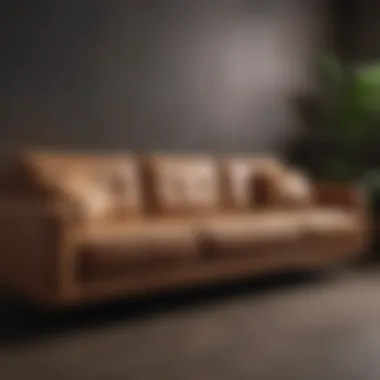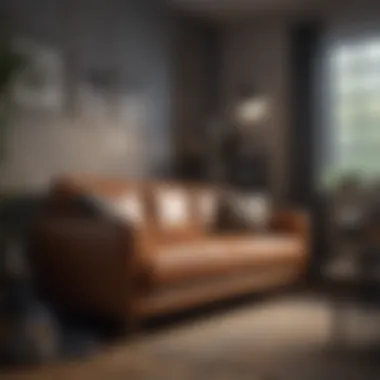Practical Methods for Effective Couch Removal


Intro
Removing a couch can feel like battling a dragon. It's often more than just dragging an old piece of furniture out the door; it’s about understanding its structure, knowing the tools at your disposal, and navigating the logistics tied to your living space. The process isn’t just practical—there’s an aesthetic element to consider as well. How will your living room transform post-removal? This guide aims to equip you with essential insights, techniques, and considerations, demystifying the couch removal saga.
Key Insights and Trends
When it comes to interior design, the current wave is leaning towards minimalist aesthetics. Homeowners are opting for furniture that serves multiple purposes—think sleek, multifunctional sofas that can also function as a storage unit. Thus, making the decision to remove a traditional couch can bring about a revitalization of your living space, ushering in trends more aligned with fluidity and adaptability in design.
As for trends in disposal and recycling, there's a surge in eco-conscious practices. People are more likely to part with their couches responsibly, exploring avenues like donation or recycling instead of simply tossing them into a landfill. This inclination not only speaks to sustainability but also aligns with modern consumers’ perspectives on responsible living.
**"The act of removing and replacing furniture is not merely a reflection of style, but also of values and lifestyle choices."
Practical Tips and How-To Guides
Taking on the task of couch removal can be daunting, but with a structured approach, it’s quite manageable. Here’s a step-by-step breakdown:
- Assess the Situation: Examine the couch’s dimensions, weight, and assembly style. Is it a solid piece, or can it be disassembled?
- Gather Your Tools: Ensure you have the necessary tools before you dive in. A screwdriver, wrench, utility knife, and possibly a hammer can help. If you're feeling ambitious, a reciprocating saw can work wonders too.
- Disassemble: If your couch allows it, start taking apart sections. Always be cautious with sharp edges—this is where the gloves come in handy.
- Clear a Path: Before you attempt to move it, clear the area. Watch out for low doorways or tight corners that could snag your progress.
- Lift Safely: Use proper lifting techniques to avoid injury. Bend your knees instead of your back, and when possible, have a friend assist.
- Dispose Responsibly: Determine if your couch is salvageable. Maybe it’s suitable for donation. Alternatively, check local regulations for furniture disposal or recycling options.
- Clean Up: After it’s gone, don’t forget to clean the area where the couch resided. You might find dust bunnies lurking or little treasures you thought were lost.
Using these strategies can transform a grueling task into a more natural part of home management, thus enhancing your living environment. Diving deeper into the specifics of your couch type and its assembly will further refine your removal technique.
By taking practical approaches toward couch removal, you’re not just clearing physical space; you're allowing a shift in energy and style in your home.
Understanding Couch Structures and Types
Understanding the various couch structures and types might appear a simple task at first glance, yet, it grips the core of why couch removal can be a real hassle. Being informed about what materials and styles you're dealing with sets the stage for an efficient removal. It's not merely about hauling away a bulky piece of furniture; it’s recognizing how its specific construction may affect your approach. Knowing whether you’re dealing with a leather sectional or a fabric loveseat, for instance, directly influences the necessary tools and techniques.
Common Couch Materials
Fabric
When it comes to fabric couches, their soft texture often makes them comfortable and inviting. One of the key characteristics of fabric is its vast array of designs and colors, offering ample opportunity for personalization in interior decor. Fabric couches are generally lighter than their leather counterparts, making them easier to maneuver out of tight spots. However, their major disadvantage includes susceptibility to stains and wear over time. If the fabric gets soaked or damaged, it could lead to significant cleaning or replacement costs.
- Advantages:
- Disadvantages:
- Variety in styles and colors.
- Generally lighter for transportation.
- Vulnerable to staining.
- Potential wear and tear require maintenance.
Leather
Leather couches, often linked with luxury and durability, provide a distinctive and elegant touch to living spaces. The primary advantage of leather is its resilience; when cared for properly, it lasts much longer than fabric options. Another key feature is that leather tends to be easier to clean. However, potential downsides include their heavyweight nature, which can complicate removal.
- Advantages:
- Disadvantages:
- Long-lasting and durable.
- Easy to wipe and maintain.
- Can be cumbersome to move due to weight.
- Less variety in prints compared to fabric.
Wood frames
Wooden frames offer sturdy construction that is a hallmark of quality couches. They provide the necessary support and stability, making them advantageous for everyday use. The striking appearance of a wooden frame can elevate a room's decor. However, they can be heavy and cumbersome, making removal a bigger challenge. Additionally, wooden frames can sometimes be affected by humidity, making them less desirable in certain climates.
- Advantages:
- Disadvantages:
- Highly durable and stable.
- Enhances aesthetic appeal in home decor.
- Hefty and difficult to maneuver.
- Susceptible to moisture damage.
Types of Couches
Sofas
Sofas are arguably the most common type of couch found in households. They are typically designed for multiple people, making them an ideal choice for social gatherings. Their prominent feature is comfort and versatility. Sofas can come in varied styles, from traditional to modern, and can be dressed up or down depending on decor needs. Despite their multi-functionality, their bulkiness might pose a difficulty during removal, especially in narrow hallways.
- Advantages:
- Disadvantages:
- Versatile and suitable for various settings.
- Offers ample seating.


- Can be heavy and large.
- Requires planning for tight spaces during removal.
Sectionals
Sectionals have become synonymous with contemporary living. They provide expansive seating arrangements that can fit snugly into different layouts. Their unique ability to be rearranged into various configurations is a key selling point. Nevertheless, their design can render them complex to disassemble, especially when attempting to detach modular sections.
- Advantages:
- Disadvantages:
- Offers customizable seating.
- Fits well in open-concept spaces.
- Complicated removal process.
- May require additional tools for disassembly.
Loveseats
Loveseats are characterized by their compact design, making them ideal for smaller living areas or as an accent piece in larger rooms. They offer a cozy atmosphere for two and can serve diverse purposes, from additional seating to a decorative piece. However, their limited space may not cater to larger groups, making them a less practical option in social situations.
- Advantages:
- Disadvantages:
- Space-saving option for smaller rooms.
- Offers a charming aesthetic appeal.
- Limited size limits functionality.
- Might not accommodate larger groups during gatherings.
Preparation for Couch Removal
Preparing for the removal of a couch can make the process smoother and less stressful. It sets the stage for what can be a physically demanding job, especially if you have a larger piece of furniture to handle. When you take the time to assess your space and gather the necessary tools, you're effectively creating a well-thought-out plan that can lead to a successful removal. This preparation is useful not only for ensuring a safe process but also for minimizing potential damage to your home.
Assessing the Space
Dimensions of the room
The dimensions of the room are a fundamental consideration when planning to remove a couch. Knowing how much space you’re working within can greatly shape your approach. The key characteristic here is understanding the width and height of your entryways, such as doors and windows, as these will dictate how the couch can be maneuvered out. A spacious room can be a blessing, providing multiple angles to attempt for removal. Conversely, cramped quarters can complicate matters significantly.
The unique feature about measuring your room size is that it relates directly to the angles and strategizing required. If you find the measurements are marginally smaller than the couch dimensions, you might need to plan for disassembling sooner. Do heed the idea that while multiple angles are good, sometimes they may introduce tighter spots where the couch can snag.
Access to doorways and hallways
Access to doorways and hallways can either facilitate or hinder the couch removal process. You want to pay close attention to the paths you’ll take. A wide doorway can be a game changer, allowing for a straightforward exit route, while narrow hallways can create bottlenecks, potentially causing undesirable scratches to your couch or walls.
The unique aspect of evaluating this access is looking at potential obstacles like furniture or decor that might also be in the vicinity. For example, a feature like a potted plant or an art piece can hinder movement. Also, think about whether you might need to remove any items temporarily to clear a path. This preparatory step helps clear your mental map of the environment so you can navigate smoothly.
Gathering Necessary Tools
Screwdriver
A screwdriver is one of those tools that you might not think about unless you really need it. Preparing to dismantle components of the couch—like legs or cushions—can make a remarkable difference in how easily you can move it. The key attribute of a screwdriver is its versatility, as it can help you tighten or loosen screws at a moment’s notice. It’s a beneficial addition to your toolkit, especially if your couch has been assembled in such a way.
One unique point about screwdrivers is the different types available: Phillips, flathead, and even star-shaped. Each type caters to specific types of screws found in furniture, enhancing your chances to get the job done without a hitch. However, a common disadvantage is that if you don’t have the right type handy, it might delay your progress.
Utility knife
When you think about a utility knife, you might just associate it with cutting cardboard or boxes. Yet, this humble tool plays a crucial role in couch removal tasks. This knife allows you to carefully slice through fabric and any ties or fastenings that may be holding your couch's structure intact. The key characteristic of a utility knife is its precision, which can help prevent unnecessary damage while working.
An interesting feature of utility knives is the replaceable blades. The more you use one, the more chances you have to switch out blades for better, cleaner cuts. On the flip side, they can be dangerous if not handle properly—so caution is key when you’re tearing into fabrics.
Furniture dolly
Lastly, a furniture dolly is an invaluable asset during the physical transportation phase of couch removal. This wheeled platform makes it a breeze to roll heavy furniture without the risk of strain on your back. The key attribute here is the ease of transport, as it allows you to move large items across various surfaces without damaging floors.
What’s unique about furniture dollies is the adaptability; some are equipped with straps that help secure your couch—perfect for maintaining stability during movement. However, the downside could be if you have stairs involved, it might not be the ideal solution unless you have the ability to lift it at intervals.
Safety Considerations
Wearing gloves
Don’t underestimate the power of wearing gloves during your couch removal. This safety measure can protect your hands from sharp edges, splinters, or any hazardous materials found on an older couch. The notable aspect of this protective choice is that it allows you to grip better while ensuring your skin is'nt at risk of cuts. It’s particularly beneficial if you’re handling a couch that’s been in your home for years with accumulated wear and tear.
One unique feature about gloves is the range of materials available—from disposable latex to sturdy leather. Each type caters to different removal tasks. However, if they fit poorly or slip off, they could hinder rather than help.
Protecting floors and walls


Lastly, protecting your floors and walls should be at the forefront of your removal strategy. A little foresight in this area can save a world of trouble later on. You can use old blankets or cardboard to shield your surfaces from scratches or scuff marks during the moving process. The key benefit of this approach is damage mitigation—avoiding costly repairs or refinishing afterward.
What’s particularly unique is how this protection encourages responsible moving. When one is mindful of surroundings, it not only reflects well on the homeowner but can also help avoid unintended accidents during transport. In contrast, if you neglect this step, you could end up with significant repair expenses that could have easily been avoided.
Step-by-Step Removal Process
Understanding the step-by-step process for couch removal is crucial for many reasons. It streamlines the entire operation and reduces the risk of damage to both the furniture and the environment. By breaking down the removal into smaller, manageable tasks, you can work methodically through each stage, avoiding chaos or confusion. Effectively implementing this structured approach limits injuries and ensures the transition is smooth, whether you’re simply rearranging your living space or making room for something entirely new.
Disassembling the Couch
Removing cushions
Removing the cushions from your couch is often the first step in disassembly, and it plays a pivotal role in simplifying the overall removal process. This action has a dual purpose: it not only reduces the weight of the couch but also opens up access to any screws or bolts that may be hidden beneath. The key characteristic of removing cushions is its straightforwardness and immediacy, making it a popular and beneficial choice among homeowners.
A unique aspect of this step is that you can examine the cushions for wear and tear while you’re at it. This allows for potential future upgrades or repairs, making it valuable not just for the removal task but also for the long-term maintenance of your seating.
Unscrewing components
Unscrewing components is another vital step in the couch removal process. It allows you to effectively detach various parts, ensuring that each section can be handled separately, which is essential when dealing with larger pieces. The primary advantage of this step is that it minimizes the risk of damaging the couch or your living space.
Key features of unscrewing components include accessibility and added safety. This method is beneficial as it decreases the bulk of the couch, making maneuverability simpler, especially when navigating through narrow hallways or doorways. However, be mindful of keeping track of screws and small parts, as losing these can complicate potential reassembly.
Transporting the Couch
Using a dolly
When it comes to transporting the couch, employing a dolly is one of the most effective choices a homeowner can make. Utilizing a dolly not only lifts some of the burden off your back but also provides a sturdy platform, ensuring that the couch moves securely. Its key characteristic is efficiency, allowing for smooth transitions across different surfaces with minimal effort.
A unique feature of using a dolly is its ability to handle significant weight with ease. This can be especially advantageous for anyone worried about lifting heavy furniture. However, it’s crucial to ensure the couch is properly secured to the dolly; if not, it can pose risks of shifting or falling during transport.
Navigating tight spaces
Navigating tight spaces is a significant consideration when removing a couch from your home. Many homes present challenges, from narrow door frames to tight corners. Mastering the art of maneuvering through these constraints contributes to a successful removal process as it enables you to transport the couch without damaging the item or your home. The main benefit here is that it pushes you to think creatively about angles and positions while maintaining your couch’s integrity.
A unique aspect of tight space navigation is the necessity for patience and ingenuity. It can sometimes involve disassembling further than anticipated or making adjustments on the fly. While it may seem like a drawback, it often leads to a deeper understanding of your furniture and the space it occupies, enhancing your capabilities for future arrangements.
Cleaning the Area
Vacuuming debris
Once the couch has been successfully removed, vacuuming up any debris left behind is an important practice. This step is more than just a cosmetic improvement; it raises the overall hygiene of the space by removing dust, allergens, and any leftover particles that could have settled. The main part of vacuuming is its thoroughness, as it clears the ground of unwanted debris.
An interesting feature of vacuuming after couch removal is that it grants you the ability to refresh the entire area. This is particularly helpful if you plan on introducing new furniture, creating a cleaner and more inviting atmosphere. However, it's necessary to ensure that the vacuum is appropriate for the surface, as some models can damage delicate floors.
Addressing stained surfaces
Addressing any stained surfaces after couch removal is essential for maintaining the aesthetic of your living space. Stains often become hidden under the couch, and once the couch is gone, it’s crucial to tackle those unsightly marks. The key characteristic of dealing with stains is that it often requires a tailored approach, as various materials and types of stains call for different cleaning methods.
A unique aspect of addressing stained surfaces is the potential to uncover issues that have been long overlooked. This can be both a good and a bad surprise, depending on what you find. While tackling stains can be labor-intensive, the upside is that restoring beauty to the floor can significantly enhance the appeal of the room, making it feel fresh and revitalized.
Couch Disposal Options
Disposing of a couch is an essential part of the removal process that shouldn't be taken lightly. Not only is it about getting rid of an old piece of furniture, but it also involves considerations around environmental impact, community assistance, and even potential financial factors. With all these elements woven into the decision-making process, understanding disposal options becomes essential in making informed choices. This section explores various avenues like donations, recycling, and junk removal services that can help streamline this process while supporting both personal and communal goals.
Donation Opportunities
Local charities
When considering couch disposal, local charities stand out as a win-win option. Donating your couch to a charity not only extends the life of the furniture but also supports those in need. Many charity organizations, such as Goodwill and Habitat for Humanity, gladly accept gently used sofas. This option can provide a sense of fulfillment, knowing that your couch can brighten someone else's home.
One key characteristic of local charities is the potential for pickup services. Many of these organizations offer the convenience of scheduling a pickup, which saves donors the hassle of transporting heavy furniture themselves. Another unique feature is the tax deduction available for the value of the donated item, which can also enhance personal financial benefits.
However, there are a few considerations to keep in mind. Not all charities accept all types of furniture, especially heavily worn or damaged items. So, before packing up your couch, it's wise to call ahead and check specific guidelines. This step ensures that your donation effort is not a fruitless endeavor.
Facebook Marketplace
Facebook Marketplace has emerged as a popular option for those looking to sell or give away their sofas. This platform allows users to tap into their local community quickly. The key characteristic of Facebook Marketplace is the immediacy it provides; within minutes, a listing can be created and shared, reaching interested buyers or takers in your vicinity.


The unique feature of Facebook Marketplace is the prospect of engaging directly with potential buyers, allowing for negotiation on price or condition. This aspect can be beneficial for those looking to recoup some costs or simply wanting their couch to find a good home. However, one must remain cautious. Some may face the challenge of verifying the reliability of buyers or dealing with no-shows. Clear communication and setting a concrete pickup time can alleviate such situations.
Recycling Programs
Finding recycling facilities
Given the increasing emphasis on sustainability, finding proper recycling facilities has gotten simplified in recent years. Many municipalities have stepped up their recycling game by establishing centers dedicated to handling furniture, including couches. The key characteristic of these facilities is their goal to repurpose materials, thus minimizing waste. It's a satisfying alternative for environmentally conscious homeowners looking to dispose of unwanted items responsibly.
Advantages of finding recycling facilities include the knowledge that your couch won't end up in a landfill. Instead, components may be salvaged for various uses, meaning that your discarded couch could eventually contribute to new furniture or even art installations. On the downside, not every community offers these services, and individuals may need to drive to a designated recycling point, which could entail effort and time.
Furniture take-back policies
Furniture take-back policies are another commendable recycling option that more retailers are adopting. Many companies, such as IKEA or Ashley Furniture, have begun to recognize the environmental impact of discarded furniture, hence establishing programs to take back old pieces when customers buy new ones. This key characteristic makes it particularly appealing; it streamlines the purchasing process while simultaneously addressing wastage concerns.
A significant advantage of this option is the quick and convenient resolution; purchasing a new sofa often leads to free removal of the old piece. However, a drawback could be the limited options available, as it may require a purchase to take advantage of these services. Additionally, not all retailers have such policies, so verifying this ahead of time can save last-minute surprises.
Hiring a Junk Removal Service
Evaluating costs
For those preferring a hassle-free option, hiring a junk removal service often presents itself as the simplest solution. Numerous companies specialize in furniture removal, providing the expertise and manpower needed for a smooth process. Evaluating costs is crucial here, as prices can fluctuate widely based on service reputation, distance, and volume of debris being removed. Be sure to obtain multiple quotes to find a balance between affordability and reliability.
A key characteristic of junk removal services is their flexibility in scheduling, which can be tailored to your timeframe. This ease of use can be particularly beneficial for those with busy lives. However, the disadvantages include the potential for high costs, especially if additional fees come into play. It's paramount to clarify what the fee encompasses to avoid surprises at the end of the service.
Scheduling a pickup
Scheduling a pickup with a junk removal service can take a huge load off your shoulders. Many of these companies provide an online booking system or phone service that allows customers to easily select a convenient time. This key characteristic makes junk removal a popular choice for those not wanting the labor or logistics to do it themselves.
However, a consideration is that availability could vary, especially during peak moving seasons or weekends. Customers may need to be flexible with their choices and possibly plan ahead to secure desired slots. Ultimately, while opting for professional removal may seem more costly than DIY, the time saved and convenience offered can justify the investment in many homeowners’ eyes.
Overall, choosing the right disposal option for your couch requires weighing various factors, including personal values, financial implications, and convenience. Each avenue explored offers unique benefits, and being informed will help guide your choice effectively.
Post-Removal Considerations
Post-removal considerations mark a pivotal point in the journey of couch removal. Once that hefty piece of furniture is out of the way, a world of possibilities unfolds. This phase is critical as it directly influences how the living space feels and functions. Thoughtful planning can enhance the flow of a room, ensuring everything has its rightful place, and can even boost overall comfort and aesthetic appeal. Let's unpack the significance of this step in detail, emphasizing the practical aspects that follow after the hard work of couch removal.
Assessing the Space for New Arrangements
Redesigning Room Layout
Redesigning room layout is not merely about adjusting furniture positions; it's an opportunity to breathe new life into a space. After clearing out the old couch, homeowners often find that the newly vacant area allows for creative rethinking. This process can open their eyes to better ways to utilize a room’s dimensions. One key characteristic of redesigning room layouts is its adaptability. It can cater to various needs—from optimizing seating for gatherings to enhancing movement through the room.
A common trait of this approach is incorporating flow. Oftentimes, the old arrangements are dictated by a piece of furniture like a couch, and shifting it can inspire a more fluid arrangement. However, it’s important to consider any disadvantages that might come with radical changes, such as how an unconsidered layout could create awkward pathways. Overall, redesigning a room can vastly improve how one interacts within that space.
Choosing New Furniture
Choosing new furniture becomes a pertinent task after saying goodbye to the old couch. This aspect ties directly into creating a renewed ambiance that resonates with the household's aesthetic taste. The unique feature of selecting fresh pieces is its potential to transform a stale environment into something vibrant and dynamic. Key to this aspect is functionality; the new items should ideally serve practical purposes while also being visually appealing.
A notable consideration here is the scale of new furniture. Sometimes, people may opt for smaller furniture to create a more open feel, while others may decide on statement pieces, which can be quite beneficial if done right. A popular choice in the realm of new furniture selection is the possibility of going the eclectic route; mixing styles and materials can create a personalized space, yet without careful thought, it could lead to a chaotic look that clashes. Thus, understanding one’s style and how it fits into the existing decor is crucial.
Maintaining a Functional Flow
Maximizing Space Usage
Maximizing space usage is a strategic focus that keeps the room practical after a couch removal. A room can often feel cramped depending on the arrangement of furniture, so ensuring that every nook and cranny is utilized effectively is important. The hallmark of maximizing space usage is acknowledging the room's specific needs—what serves the household purpose best?
In this context, positioning furniture wisely can totally transform how the area flows. For example, utilizing vertical space with shelves can provide storage options without hogging valuable floor space. The downside, if neglected, might include not utilizing existing architectural elements, which can add to both the clutter and inefficiency.
Creating Social Areas
Creating social areas is vital in maintaining the functional flow of a room post-couch removal. It mainly focuses on fostering connections among people in shared spaces. One key characteristic of social spaces is their ability to encourage interaction. Moving away from the traditional couch setup can lead to more inviting arrangements, such as grouped seating or open areas for activities.
A notable plus of this approach is that it can make an environment feel less formal and more inviting. A well-planned social area can adapt to various occasions, whether it’s a game night or a casual gathering. However, a downside might be forgetting the needs for personal space. Striking the perfect balance between togetherness and comfort is crucial for creating an area that invites engagement without feeling overwhelming.
"A space that welcomes community can significantly enhance daily living experiences, making it feel less like a house and more like a home."
Ending
Removing a couch is more than just a process; it’s a significant undertaking that can transform a space dramatically. The discussions within this article highlight key elements that not only guide the practical aspects of couch removal but also touch on the underlying considerations of space and design.
One of the major benefits of understanding the couch removal process is the ability to assess one’s living environment with a more critical eye. Things like dimensions of rooms and flow of movement become paramount. Each aspect of this task, from gathering the right tools to knowing how to load it on a truck, plays a vital role in executing a successful and efficient transition. It's worthwhile to plan ahead, as clear pathways and proper disassembly can reduce the risk of damage to both the furniture being removed and the surrounding decor.
Moreover, eco-friendly disposal options add another layer of responsibility. When homeowners opt for recycling or donating, they contribute to sustainable practices that benefit the community. This article emphasizes that every action taken during couch removal can lead to a ripple effect in terms of space enhancement and environmental responsibility.
The importance of this topic resonates not just with those looking to clear space, but also with anyone interested in optimizing interior design. Whether it’s for renovating a room or simply refreshing a living space, knowing the ropes can turn a daunting task into a manageable weekend project. Every key point addressed here serves the dual purpose of practicality and aesthetic enhancement, making the endeavor not only necessary but also an opportunity for creativity and improvement.



